Answer these simple questions and we will find you the BEST prices
Which type of solar quotes do you need?
It only takes 30 seconds
100% free with no obligation



- GreenMatch
- Windows
- uPVC Windows
- uPVC Window Sizes
uPVC Windows Sizes: Standard Widths & Heights

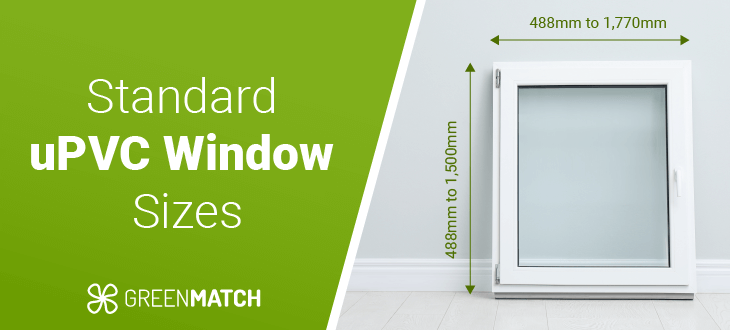
Are you looking to upgrade your home with uPVC windows but don't know where to start or how to proceed? One crucial factor to consider before shopping around is the uPVC window sizes. If you skip this step, you can still get beautiful and energy-efficient windows, but they may not fit well within your walls.
Standard uPVC window sizes vary depending on the style, which can make the decision-making process overwhelming. However, understanding the different uPVC window sizes can ensure you choose the perfect fit for your home.
uPVC window sizes in the UK typically range from 488mm to 1,770mm in width and 488mm to 1,500mm in height, but this varies by style. For example, a casement window typically ranges from 635mm to 750mm in width and 900mm to 1,500mm in height, while a sash window ranges from 914mm to 2,134mm in width and 609mm to 1,524mm in height.
Too complicated? It doesn’t need to be. If you are ready to upgrade your home with modern uPVC windows, the easiest and smartest way is using GreenMatch’s free quotes service. Our team of experts on domestic energy solutions will:
- save you from the stress of spending hours searching for installers
- send you up to 3 quotes from top-rated uPVC window suppliers near you
- match you with providers who meet the highest quality standards
Get started by clicking the button below.
- Quotes from local engineers
- Payment by finance available
- Save up to £140 per year
It only takes 30 seconds



Standard uPVC window sizes
uPVC windows are available in a range of standard sizes to cater to different needs. According to industry standards, a large uPVC window design can have a size of up to 2.65 metres squared. Some manufacturers offer custom-made, extra-large uPVC windows that can be even bigger, with sizes up to 4 metres squared or more.
On the other hand, small UPVC windows are also available to suit the specific requirements of a given space. In any case, the different window styles in uPVC are probably the most important factor determining standard UK uPVC window sizes.
For example, considering the sash style, a 1200 x 1200 uPVC window is within the standard uPVC window sizes in the UK. The same measurements, nevertheless, would make top-hung windows fall outside the category of standard-size uPVC windows.
Always keep in mind that every windows manufacturer has their own set limits in terms of the minimum and maximum dimensions they will allow.
There are several factors that can affect the maximum width and height one window can reach. This includes:
Below, you can find a table summarising uPVC windows standard sizes in the UK. Right after, the following sections will delve into what uPVC window sizes are standard for different window styles.
| uPVC Standard Window Sizes (Widths & Heights) | |
|---|---|
| Standard uPVC window widths | Standard uPVC window heights |
| 488mm (19 inches) | 488mm (18 inches) |
| 630mm (25 inches) | 600mm (24 inches) |
| 915mm (36 inches) | 1,050mm (42 inches) |
| 1,200mm (48 inches) | 1,200mm (48 inches) |
| 1,770mm (70 inches) | 1,350mm (54 inches) |
| 1,500mm (60 inches) | |
Sash windows
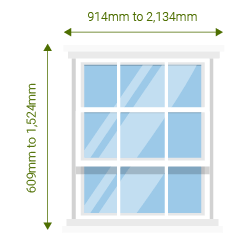
Sash windows are windows that consist of two vertically sliding panels, also known as sashes. They are typically made of multiple small glass panes held together. In addition to uPVC, other common options include timber windows and aluminium windows.
Sash windows are a popular choice for traditional or period properties, and are known for their elegant design and ability to provide excellent ventilation. They typically range in size from 914mm to 2,134mm in width and 609mm to 1,524mm in height, making them a versatile option for different home styles and sizes.
| Standard Sash Window Sizes (Widths & Heights) | |
|---|---|
| Standard Window Widths | Standard Window Heights |
| 914mm | 609mm |
| 1,219mm | 914mm |
| 1,524mm | 1,219mm |
| 1,829mm | 1,524mm |
| 2,134mm | |
Casement windows
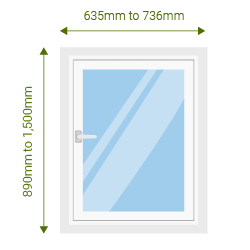
Casement windows are hinged on one side and open outward, like a door, using a crank or lever mechanism to operate. They are typically made up of a single pane of glass, although they can also feature multiple panes divided by muntins.
Casement windows are popular for modern homes and buildings, as they provide a sleek and streamlined appearance. They generally range from 635mm to 736mm in width and 890mm to 1,500mm in height, although custom sizes can be manufactured to fit specific requirements.
| Standard Casement Window Sizes (Widths & Heights) | |
|---|---|
| Standard Window Widths | Standard Window Heights |
| 635mm | 890mm |
| 736mm | 1,194mm |
| 1,498mm | |
Tilt and turn windows
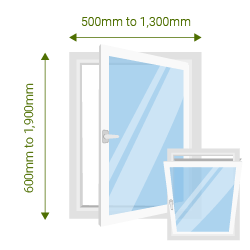
Tilt and turn windows are a versatile type of window that can open in two ways. They can either be tilted inward from the top for ventilation or turned inward from the side for easy cleaning and maintenance.
They are typically made up of one or more panes of glass and are popular in modern homes and buildings due to their functionality and contemporary appearance. Tilt and turn windows generally range from 500mm to 1,300mm in width and 600mm to 1,900mm in height. Custom sizes are also available.
| Standard Tilt and Turn Window Sizes (Widths & Heights) | ||
|---|---|---|
| Type | Standard Window Widths | Standard Window Heights |
| Single Tilt and Turn | 500mm (min) | 600mm (min) |
| 1,300mm (max) | 1,900mm (max) | |
| Double Tilt and Turn | 1,200mm (min) | 600 (min) |
| 2,400mm (max) | 1,700mm (max) | |
| Triple Tilt and Turn (2 Outer Opening Panes) | 1,600mm (min) | 600 (min) |
| 3,000mm (max) | 1,900mm (max) | |
Bay windows
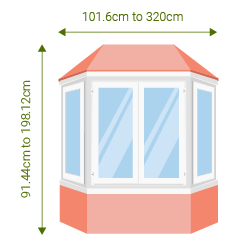
Bay windows protrude outward from the wall of a building. They are typically made up of three or more windows angled to create a bay or alcove inside the building. Bay windows provide a range of benefits, such as increasing natural light, providing a wider view of the outside, and creating additional space inside the room.
Bay windows come in a variety of sizes, with widths ranging from 101.6cm to 320cm and heights ranging from 91.44cm to 198.12cm. The size of a bay window can vary depending on the building's architecture and the room's intended use.
| Standard Bay Window Sizes (Widths & Heights) | |
|---|---|
| Standard Window Widths | Standard Window Heights |
| 101.6cm (minimum width) | 91.44cm (minimum width) |
| 320cm (maximum width) | 198.12cm (maximum width) |
Bow windows
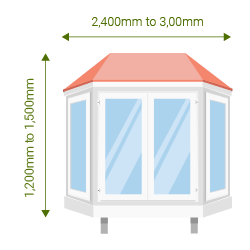
Bow windows are curved windows that protrude from the wall of a building, creating an arc or angle. They are often used as a design feature to add more natural light and space to a room. Bow windows consist of three to six individual windows that are connected together, creating a more rounded appearance than bay windows.
Standard bow windows are usually 2,400mm to 3,000mm in width and 1,200mm to 1,500mm in height, but they can be customised to fit specific requirements. Bow windows are commonly used in living rooms, dining rooms, and bedrooms to add a unique touch to the space.
| Standard Bow Window Sizes (Widths & Heights) | |
|---|---|
| Standard Window Widths | Standard Window Heights |
| 2,400mm | 1,200mm |
| 3,000mm | 1,500mm |
Be it sash, casement, tilt and turn, or any other style, getting windows of the right size is essential to ensure functionality and even improve energy efficiency. If you are unsure what uPVC window size you need, we can put you in touch with up to 4 top-rated suppliers in your area for expert advice.
At GreenMatch, we ensure the local companies we match you with meet the highest quality standards. Our service is 100% free, and you are not obliged to accept any quote you receive. To start, just click on the button below.
- Quotes from local engineers
- Payment by finance available
- Save up to £140 per year
It only takes 30 seconds



How to measure your existing windows
Measuring uPVC windows accurately is essential to ensure you get the right size and fit for your replacement windows. It can even determine if the window will achieve your desired energy efficiency standards. Here is a step-by-step guide on how to measure windows correctly:
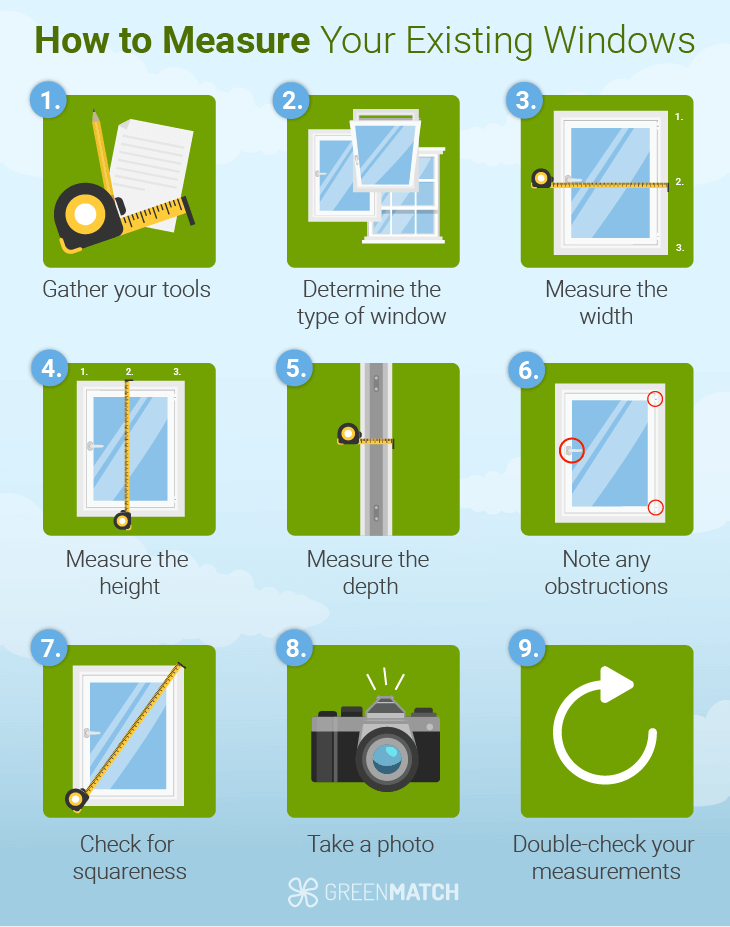
Get the best deal on replacement windows
Without a doubt, comparing quotes is one of the best ways to get the best deal on replacement windows. This is why:
However, manually searching for local window companies and requesting quotes one by one can be tedious and time-consuming. This is where GreenMatch can help you. Our free quotes service is designed to provide assistance in finding top installers in your area, ensuring you get the best deal. Check out how it works:
- Quotes from local engineers
- Payment by finance available
- Save up to £140 per year
It only takes 30 seconds



FAQ
The maximum size of uPVC windows depends on the manufacturer and style. According to industry standards, a large uPVC window design can have a size of up to 2.65 metres squared, but custom-made, extra-large uPVC windows can be even bigger, with some manufacturers offering sizes up to 4 metres squared or more.
The standard size of uPVC windows varies depending on the specific style, but generally, they range from 488mm to 1,770mm in width and 488mm to 1,500mm in height in the UK.
There is no universal standard window size or height as it varies depending on factors such as the building’s design and the local building codes. However, there are common standard sizes for different types of windows that can be used as a starting point for measurements.
The standard UPVC frame width can vary depending on the window style but generally ranges from 488mm to 1,770mm.

Luis Antonio is a seasoned Content Writer with international journalism experience. His writing style, enriched by a Master’s in Journalism, contributes informative content to GreenMatch on topics including low-carbon heating systems.

We strive to connect our customers with the right product and supplier. Would you like to be part of GreenMatch?

